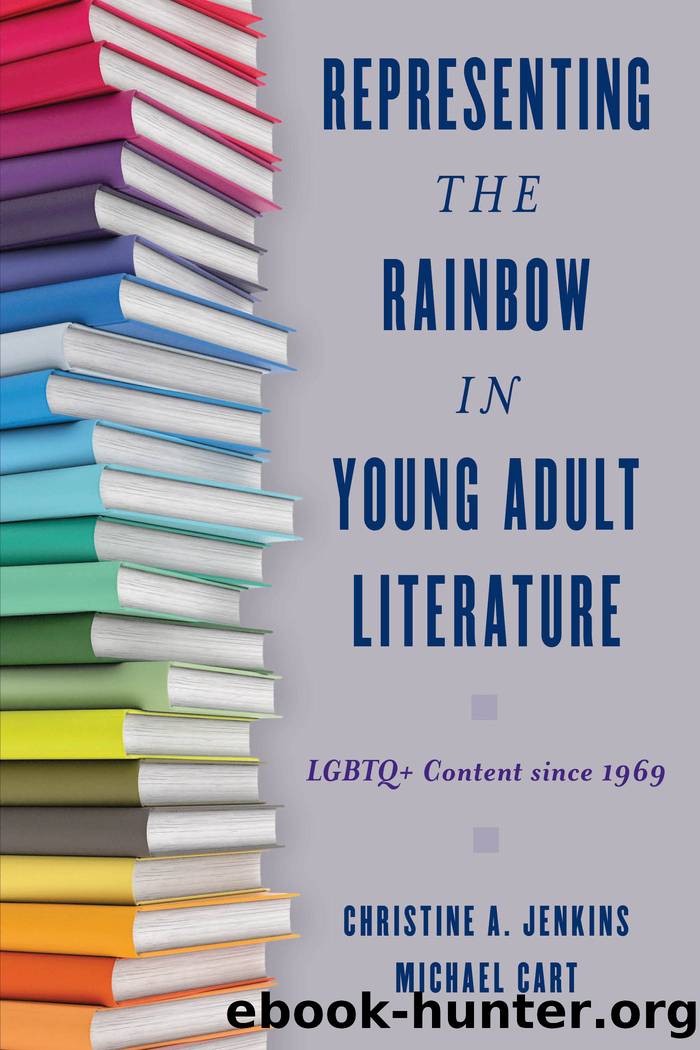Representing the Rainbow in Young Adult Literature by Christine A. Jenkins

Author:Christine A. Jenkins
Language: eng
Format: epub
Tags: undefined
Publisher: Rowman & Littlefield Publishers
Published: 2012-09-15T00:00:00+00:00
Whether he is gay or not (and it becomes increasingly obvious to readers that he is [âI suppose I am gay,â Simon finally admits to himself] [515]), Simon and Baz begin a relationship (âI want to be your boyfriend,â Simon tells Baz [390])âa relationship that is at once tender and stormy and, for the reader, deeply satisfying. It is also secret until, at the bookâs end, at a school party, the two come out, as they dance together and Simon kisses Baz.
There is, of course, more going on while all this is happening The Humdrum is still busily gobbling up magick; the revolutionary Mage is carrying on an unofficial war against the established families like Bazâs; Simon encounters the Humdrum in a wonderfully dramatic set-to, and more. But what underlies and survives all of this is the boysâ love for each other. And so Carry On is not only an epic fantasy, it is also a beautifully realized romance.
But enough of fantasy, back to realistic fiction now and a more sober view of coming out in Jenny Downhamâs British import Unbecoming. Katie hates the claustrophobia of her small hometown, âa place where once rumors began, they easily spreadâ (8). At the root of this feeling is the fact that Katie has, unbidden, kissed her best friend Esme, been betrayed by her, and made a social pariah. âThey think Iâm a freak,â she says ruefully of Esmeâs gaggle of girlfriends (61). This is bad enough, but to make matters worse, her elderly grandmother, who suffers from Alzheimerâs, has come to live with her, her mother, and her brother after an absence of many years. Once this fact is established, the main narrative then moves back and forward in time to portray the grandmotherâs childhood and early adulthood. As for Katieâs secretive present life (her mother doesnât know about Esme), she feels that if it is to improve, she has to get her best friend back. But how? Encountering Esme at a party as she had hoped, Katie tries to engage her in conversation. âI miss you,â Katie says. âI thought we were friends.â âMy friends donât jump me,â Esme replies coldly. âI didnât. You know I didnât. Why are you telling everyone that?â When Esme doesnât respond, Katie continues: âI miss us. Thereâs so much you donât knowâ (121). Esmeâs response is to say that Katie has been observed hanging out at a café where a girl named Simona, an out lesbian, works. Katie tries to explain she goes there because her grandmother, Mary, likes the place. âSee, this just sounds like lies,â Esme retorts. âSo, Iâm guessing youâve decided thatâs what you are now. Someone like Simona Williams, I meanâ (122). âWhat? No,â Katie insists. But Esme refuses to believe her, and the conversation ends badly. Several days later Simona invites Katie for coffee. A shocked Katie says no and, panicked, runs for her life but soon finds herself questioning who she is. And finds herself actually talking with Simona about her uncertainties and finally saying, âTeach me.
Download
This site does not store any files on its server. We only index and link to content provided by other sites. Please contact the content providers to delete copyright contents if any and email us, we'll remove relevant links or contents immediately.
Never by Ken Follett(2880)
Fairy Tale by Stephen King(2069)
Will by Will Smith(2041)
Reminders of Him: A Novel by Colleen Hoover(1879)
Cloud Cuckoo Land by Anthony Doerr(1434)
The Becoming by Nora Roberts(1330)
Friends, Lovers, and the Big Terrible Thing by Matthew Perry(1327)
A Short History of War by Jeremy Black(1300)
The Strength In Our Scars by Bianca Sparacino(1244)
Go Tell the Bees That I Am Gone by Diana Gabaldon(1234)
Cytonic by Brandon Sanderson(1227)
515945210 by Unknown(1207)
443319537 by Unknown(1072)
Wish You Were Here by Jodi Picoult(1056)
Works by Richard Wright(1018)
The Last Graduate by Naomi Novik(1016)
Going There by Katie Couric(991)
The 1619 Project by Unknown(989)
472244821 by Unknown(983)
